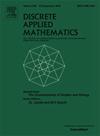Resistance distances in generalized join graphs
IF 1
3区 数学
Q3 MATHEMATICS, APPLIED
引用次数: 0
Abstract
Let be a graph with vertex set . The generalized join graph is obtained from by replacing each vertex with a graph and joining each vertex in with each vertex in provided . If every is an independent set of vertices, then we write as , which is called the blow-up of . In this paper we introduce the local complement transformation in electrical networks and obtain an electrically equivalent graph of . As their applications, we obtain formulae for resistance distances of some vertex-weighted graphs and give a unified technique to compute resistance distances in when every for is a graph consisting of a matching and isolated vertices, which results in closed formulae for resistance distances of when are some given graphs.
广义连接图中的电阻距离
设 H 是顶点集 V(H)={v1,v2,...,vk} 的图。将每个顶点 vi 替换为一个图 Gi,并将 Gi 中的每个顶点与 Gj 中的每个顶点连接(条件是 vivj∈E(H)),就得到广义连接图 H[G1,G2,...,Gk]。如果每个 Gi 都是 ni 个顶点的独立集合,那么我们就把 H[G1,G2,...,Gk] 写成 H[n1,n2,...,nk],这就是所谓的 H 放大图。作为其应用,我们得到了一些顶点加权图的电阻距离公式,并给出了一种统一的技术来计算 H[G1,G2,...Gk] 中的电阻距离,当 1≤i≤k 的每个 Gi 都是由匹配顶点和孤立顶点组成的图时,从而得到了当 H 是一些给定图时 H[G1,G2,...Gk] 的电阻距离的封闭公式。
本文章由计算机程序翻译,如有差异,请以英文原文为准。
求助全文
约1分钟内获得全文
求助全文
来源期刊

Discrete Applied Mathematics
数学-应用数学
CiteScore
2.30
自引率
9.10%
发文量
422
审稿时长
4.5 months
期刊介绍:
The aim of Discrete Applied Mathematics is to bring together research papers in different areas of algorithmic and applicable discrete mathematics as well as applications of combinatorial mathematics to informatics and various areas of science and technology. Contributions presented to the journal can be research papers, short notes, surveys, and possibly research problems. The "Communications" section will be devoted to the fastest possible publication of recent research results that are checked and recommended for publication by a member of the Editorial Board. The journal will also publish a limited number of book announcements as well as proceedings of conferences. These proceedings will be fully refereed and adhere to the normal standards of the journal.
Potential authors are advised to view the journal and the open calls-for-papers of special issues before submitting their manuscripts. Only high-quality, original work that is within the scope of the journal or the targeted special issue will be considered.
 求助内容:
求助内容: 应助结果提醒方式:
应助结果提醒方式:


